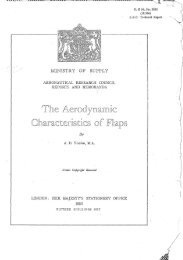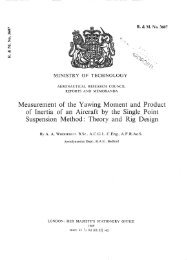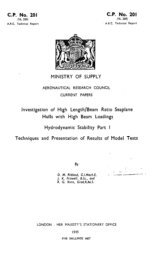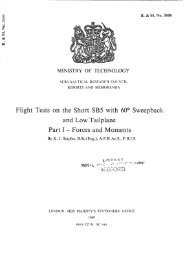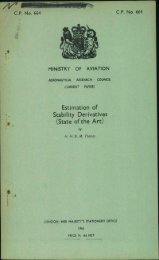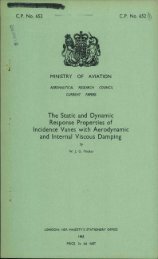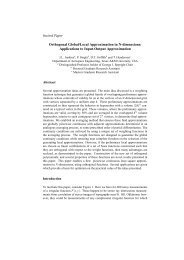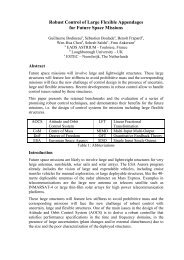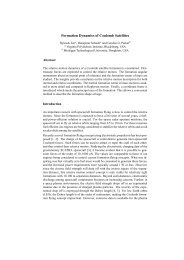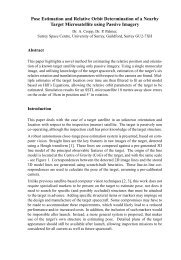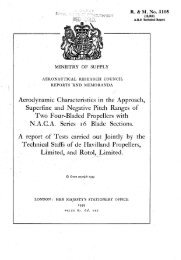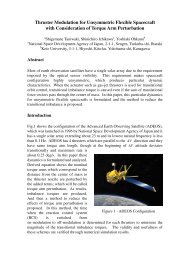The Prediction of Helicopter Rotor Hover Performance using a ...
The Prediction of Helicopter Rotor Hover Performance using a ...
The Prediction of Helicopter Rotor Hover Performance using a ...
You also want an ePaper? Increase the reach of your titles
YUMPU automatically turns print PDFs into web optimized ePapers that Google loves.
<strong>of</strong> 0.4 and 0.5 were made up based on past experience <strong>of</strong> aer<strong>of</strong>oil characteristics<br />
and the available data.<br />
<strong>The</strong> results for the rotor presented in Ref.6 have been corrected for ground<br />
effect and whirl stand interference and a similar correction has been applied to<br />
the more recent results. <strong>The</strong> calculated performance <strong>of</strong> the rotor is compared<br />
with the experiments in Fig.13, which also shows the results predicted by strip<br />
element-momentum theory. <strong>The</strong> effect <strong>of</strong> the wake is expected to be quite large<br />
for a six bladed rotor, and Fig.13 shows that the simple theory underestimates<br />
the rotor power by between 6 and 15%. <strong>The</strong> present method is much closer to the<br />
experiments and could possibly be even better if the aer<strong>of</strong>oil data had not been<br />
so sparse. <strong>The</strong> accuracy <strong>of</strong> the whirl stand facility is quoted to be. ±2% <strong>of</strong><br />
thrust at a given value <strong>of</strong> torque and the present method gives results just out<br />
side the lower bound at high thrust. No adjustments to the coordinates <strong>of</strong> the<br />
tip vortex were necessary to get this agreement whereas the tip vortex had to be<br />
moved 0.5% radius away from the blades in Ref.5. <strong>The</strong> variation <strong>of</strong> the thrust<br />
coefficient with collective pitch predicted by the theory is compared with the<br />
measurements in Fig.14. Agreement is good at low thrust but diverges as the<br />
thrust is increased. This is probably due to the high lift curve slope <strong>of</strong> the<br />
aer<strong>of</strong>oil as measured in the solid walled wind tunnel. <strong>The</strong> radial variation <strong>of</strong><br />
the blade angle <strong>of</strong> incidence predicted by the two theoretical methods is shown<br />
in Fig.15 at a high thrust coefficient. <strong>The</strong> effect <strong>of</strong> the wake is to increase<br />
the angle <strong>of</strong> incidence at the tip by nearly 50% and the blades would obviously<br />
reach the stall much earlier than predicted by the simple theory that neglects<br />
the wake.<br />
4 HOVER PERFORMANCE USING ONLY THE WAKE INDUCED VELOCITY DISTRIBUTION<br />
<strong>The</strong> results presented in section 3 show that the combination <strong>of</strong> momentum<br />
theory with the wake induced velocity distribution leads to a fairly accurate<br />
and reliable calculation method, but the question remains as to why it is neces<br />
sary to introduce momentum theory at all, when the wake induced velocity on its<br />
own should be sufficient to determine the rotor performance. Some <strong>of</strong> the reasons<br />
for this will be discussed in this section.<br />
9 .<br />
<strong>The</strong> hover performance <strong>of</strong> the Wessex main rotor measured in free flight is<br />
compared with that predicted <strong>using</strong> only the wake induced velocities and the<br />
standard wake geometry in Fig.16. <strong>The</strong> Wessex rotor has been chosen because <strong>of</strong><br />
the high quality <strong>of</strong> the experimental data and the aer<strong>of</strong>oil data for the NACA 0012<br />
13<br />
section is well defined . <strong>The</strong> predicted rotor power is about 10% too great over<br />
23



